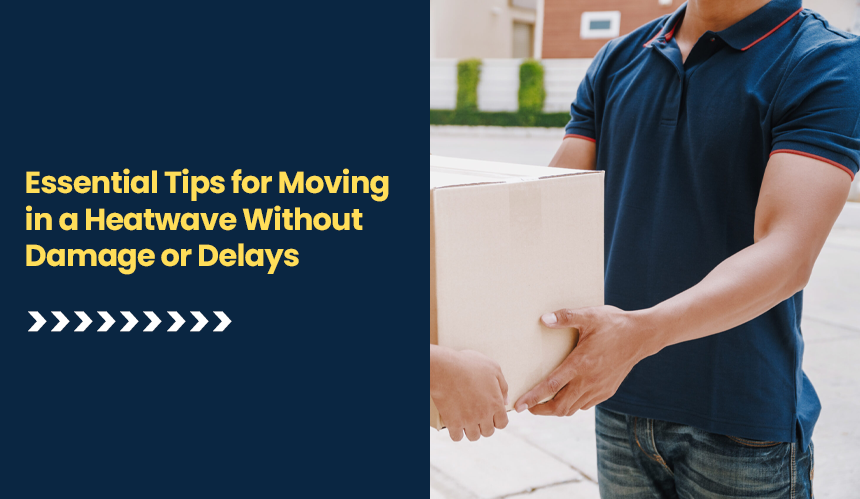
- Phil
- August 20, 2025
Essential Tips for Moving in a Heatwave Without Damage or Delays
Moving is already a stressful task, but when it happens during a heatwave, the risks multiply. Intense heat can damage household surfaces like wood and leather, harm sensitive household items such as digital equipment, and spoil food or other short-lived supplies. It also creates serious health risks for anyone involved in heavy lifting under direct sunlight.
Let’s explore the common issues you can face while moving in summer and how the right planning and proper timing can prevent damage caused by extreme heat for a smoother move.
What Are the Risks of Moving in Extreme Heat?
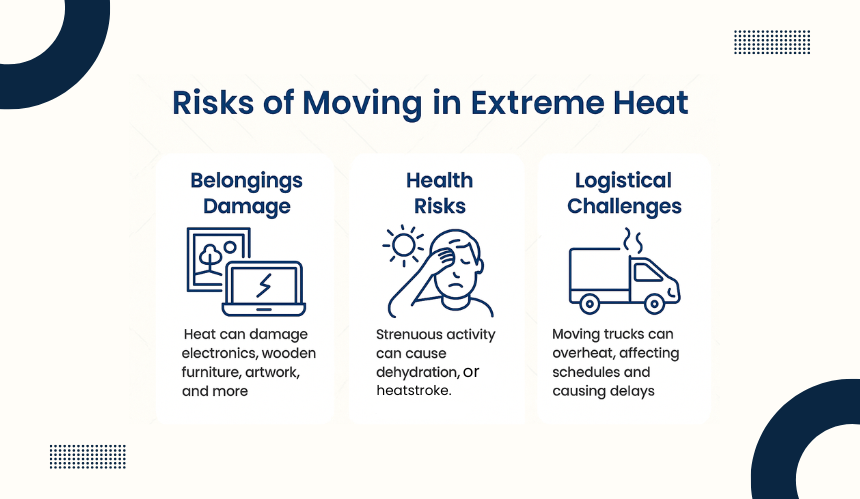
Moving during a heatwave comes with serious risks for your belongings, your health, and the moving process itself. Recognizing these risks ahead of time helps you prepare and avoid costly or dangerous setbacks.
Can Belongings Get Damaged in High Temperatures?
Yes, excessive heat can cause significant damage to household items. Electronics such as televisions, laptops, and gaming consoles may overheat or suffer from internal component failure.
Wooden furniture can expand and crack, while leather upholstery may dry out and discolor. Delicate artwork, vinyl records, candles, and perishable food items are also highly vulnerable to heat exposure during transportation.
How Does a Heatwave Affect Your Health During a Move?
Moving requires constant lifting, bending, and carrying, which puts a strain on the body. In extreme temperatures, this effort becomes more dangerous.
Prolonged exposure can lead to dehydration, heat exhaustion, or even heatstroke. Symptoms such as dizziness, headaches, nausea, or muscle cramps are warning signs that should never be ignored. Safeguarding your health is as important as protecting your belongings.
Now that the risks are clear, the next sections will explain practical solutions to prevent heat-related damage and make the moving process safer and more efficient.
What Logistical Challenges Does Extreme Heat Create?
Aside from physical and item-related risks, hot weather can disrupt logistics. Moving trucks can overheat, causing delays or even breakdowns on the road. Scheduling becomes difficult when outdoor conditions are unsafe for prolonged labor. Movers may need to adjust timelines, and DIY movers often underestimate how quickly fatigue sets in when temperatures soar.
Now that the risks are clear, the next sections will explain practical solutions to prevent heat-related damage and make the moving process safer and more efficient.
How Do You Prepare Your Home and Belongings for Heat-Safe Moving?
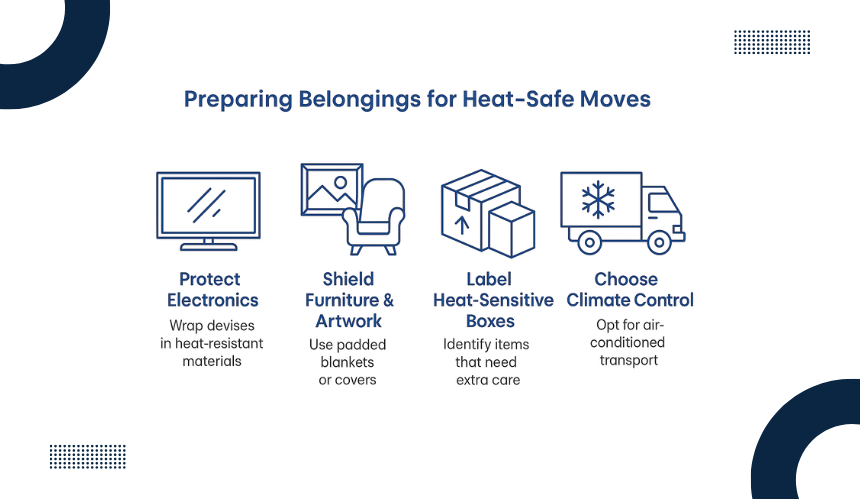
Before the first box is lifted, preparation is the key to preventing heat-related damage. Certain belongings require extra care in high temperatures. Taking the right precautions ensures your items arrive in perfect condition.
Protecting Electronics and Appliances While Moving in Extreme Heat
Electronics and appliances are among the most vulnerable items during a hot-weather move. Wrap televisions, laptops, and gaming consoles in thick, heat-resistant packing materials to reduce exposure. Avoid storing them inside a truck for long stretches, and transport smaller devices in an air-conditioned car whenever possible to keep them safe.
Preventing Damage to Furniture, Artwork, and Delicate Items
Wooden furniture can expand, warp, or crack in high heat, while leather upholstery risks drying and fading. Protect these pieces with padded blankets or moving covers that shield them from both sunlight and rapid temperature changes. For artwork, mirrors, and fragile decor, use secure wrapping materials and ensure they are not left in hot, enclosed spaces.
Using Climate-Controlled Storage and Moving Trucks for Sensitive Belongings
When transporting items like musical instruments, collectibles, family heirlooms, or valuable artwork, climate-controlled trucks or storage units are the safest choice. Residential movers recommend these solutions to regulate temperature and humidity, preventing permanent damage caused by excessive heat.
Labeling and Prioritizing Heat-Sensitive Boxes
Heat-sensitive boxes containing perishables, candles, medications, or delicate electronics should always be clearly labeled. This ensures they are identified quickly, handled with care, and unloaded into cooler areas without unnecessary delays.
Personal Safety Strategies for Moving in a Heatwave
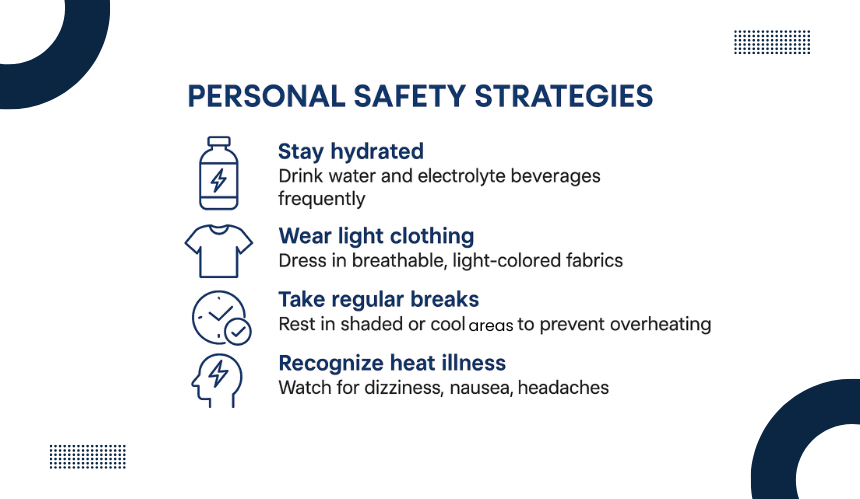
Protecting your health during a move is just as important as safeguarding your belongings. Extreme heat puts extra stress on the body, and without proper precautions, moving can quickly become dangerous. These strategies will help you stay safe and avoid heat-related illnesses.
Staying Hydrated and Maintaining Electrolyte Balance While Moving
Constant lifting and carrying in high temperatures lead to rapid fluid loss. Drinking water regularly is essential, but pairing it with electrolyte-rich beverages helps replenish sodium, potassium, and other minerals lost through sweat.
Wearing the Right Clothing to Reduce Heat Stress
Lightweight, breathable fabrics like cotton or moisture-wicking athletic wear allow the body to cool more efficiently. Choose light-colored clothing to reflect sunlight and wear a hat or cap for added protection. Proper footwear with good grip also reduces the risk of slips.
Taking Frequent Breaks to Prevent Overheating
Working nonstop in extreme heat increases the chances of exhaustion. Schedule regular breaks in shaded areas or air-conditioned rooms to allow your body to recover. Even short five-minute pauses throughout the move can lower core temperature and prevent dangerous overheating.
Recognizing the Warning Signs of Heat-Related Illness
Understanding early symptoms of heat stress is critical. Headaches, dizziness, nausea, excessive sweating, or muscle cramps may indicate dehydration or heat exhaustion.
If symptoms escalate to confusion, rapid heartbeat, or fainting, it could be heatstroke, which requires immediate medical attention.
Scheduling and Timing Your Move for Minimal Heat Exposure
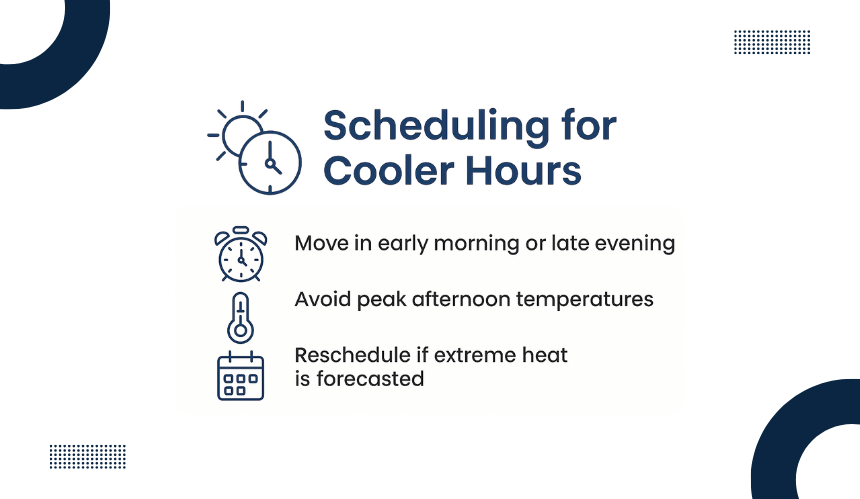
The timing of your move plays a crucial role in reducing heat-related risks. By planning around weather conditions and peak temperature hours, you can make the process safer and less exhausting for everyone involved.
Choosing the Best Time of Day to Move in a Heatwave
Early mornings and late evenings are the safest windows for heavy lifting and loading. Midday heat is the most intense, often leading to fatigue and overheating. Starting before sunrise or waiting until after sunset helps avoid peak temperatures.
Using Weather Forecasts to Adjust Your Moving Schedule
Check local forecasts before finalizing moving times. Shifting your schedule by even a few hours can make a major difference in heat levels. If extreme temperatures are predicted, it may be worth postponing the move to prevent damage and health risks.
Coordinating Movers and Helpers to Avoid Peak Heat Hours
When working with a moving company or friends, coordinate schedules around cooler hours of the day. Professional movers are often flexible and may recommend early or late shifts during heatwaves to ensure safety and efficiency.
Transportation and Vehicle Considerations During Extreme Heat
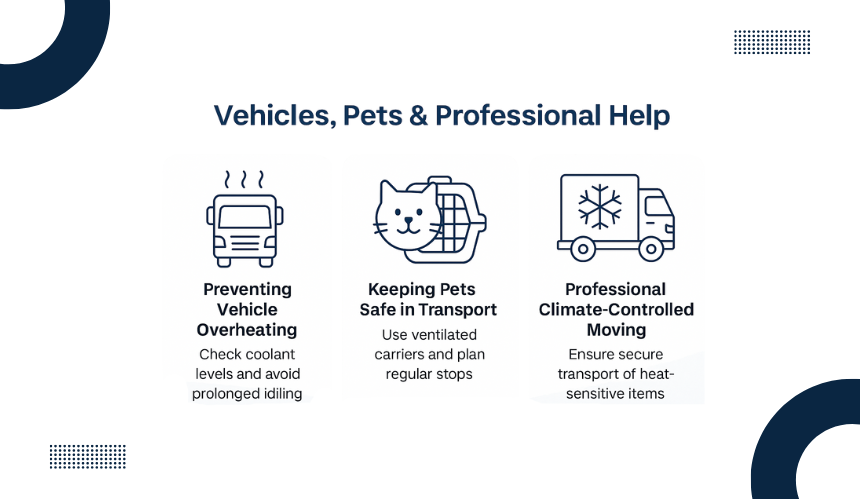
Vehicles and transportation play a critical role in a move, and hot weather creates additional challenges. From protecting your car to ensuring the safety of pets and perishable items, planning ahead prevents breakdowns and unnecessary stress.
Preventing Vehicle Overheating During a Heatwave Move
High temperatures can cause moving trucks or personal vehicles to overheat, leading to delays or costly repairs. Ensure coolant levels are topped up, check the radiator before travel, and avoid long idle times in direct sunlight. Scheduling driving times during cooler hours further reduces the risk of mechanical failure.
Keeping Pets Safe and Comfortable During Transportation
Pets are extremely sensitive to heat and should never be left unattended in vehicles. Use carriers with proper ventilation, provide water at regular intervals, and plan rest stops in shaded or air-conditioned areas. When possible, transport pets in your personal vehicle where the climate can be controlled.
Using Insulated Containers for Perishables and Heat-Sensitive Items
Food, medications, and other perishables spoil quickly in high heat. Pack them in insulated coolers with ice packs or dry ice to maintain safe temperatures. For longer moves, prioritize unloading these items first to prevent damage and waste.
How Professional Moving Services Provide Heat-Proof Solutions
Extreme heat can complicate every stage of the moving process, from packing to transportation. Professional movers help reduce these risks by offering climate-controlled trucks that regulate temperature and humidity, ensuring digital equipment and other valuables remain safe.
Professional teams use protective packing methods designed to shield items from heat damage for maximum efficiency. By relying on trained crews, the likelihood of delays, damage, and unnecessary stress is greatly minimized.
For reliable solutions during a heatwave move, A Great Moving Crew delivers the expertise, equipment, and planning needed to protect valuable belongings and keep the process running on time.
Frequently Asked Questions
Can a heatwave increase the chances of power outages that affect moving plans?
Yes. When temperatures are extremely high, power grids can become overloaded and cause outages. Keeping a cooler with ice, portable fans, or backup batteries ready can help avoid problems if the power goes out on moving day.
Do plants need special care when moving during a heatwave?
Definitely. Move plants early in the morning or late in the evening when it is cooler. Keep them shaded during transport and water them well before the move to reduce stress.
Can skin problems like heat rash happen during a hot-weather move?
Yes. Spending hours in high heat can cause skin irritation such as heat rash. Wearing loose, breathable clothing and taking short breaks in a cooler place can prevent this.
Are cooling centers or public air-conditioned spaces useful during a move?
They can be very helpful. If the home or moving truck gets too hot, stopping at a public air-conditioned place like a library or community center can give everyone a safe break from the heat.
How does humidity affect moving during a heatwave?
High humidity makes it harder for the body to cool itself, which makes the heat feel even stronger. In humid weather, it is important to drink more water, take breaks, and move at a slower pace.
Can certain medications or health conditions make moving in a heatwave more dangerous?
Yes. Some medications and health issues can make it harder to handle high heat. People with heart conditions or those taking medicines that affect hydration should be extra cautious and talk to a doctor before moving in extreme heat.

